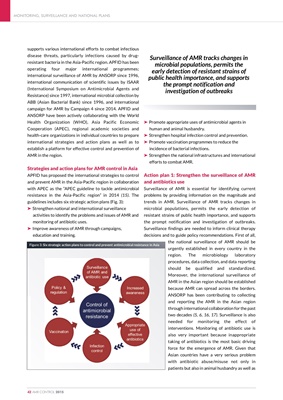
supports various international efforts to combat infectious
disease threats, particularly infections caused by drugresistant
bacteria in the Asia-Pacific region. APFID has been
operating four major international programmes;
international surveillance of AMR by ANSORP since 1996,
international communication of scientific issues by ISAAR
(International Symposium on Antimicrobial Agents and
Resistance) since 1997, international microbial collection by
ABB (Asian Bacterial Bank) since 1996, and international
campaign for AMR by Campaign 4 since 2014. APFID and
ANSORP have been actively collaborating with the World
Health Organization (WHO), Asia Pacific Economic
Cooperation (APEC), regional academic societies and
health-care organizations in individual countries to prepare
international strategies and action plans as well as to
establish a platform for effective control and prevention of
AMR in the region.
Strategies and action plans for AMR control in Asia
APFID has proposed the international strategies to control
and prevent AMR in the Asia-Pacific region in collaboration
with APEC as the "APEC guideline to tackle antimicrobial
resistance in the Asia-Pacific region" in 2014 (15). The
guidelines includes six strategic action plans (Fig. 3):
‰ Strengthen national and international surveillance
activities to identify the problems and issues of AMR and
monitoring of antibiotic uses.
‰ Improve awareness of AMR through campaigns,
education and training.
‰ Promote appropriate uses of antimicrobial agents in
human and animal husbandry.
‰ Strengthen hospital infection control and prevention.
‰ Promote vaccination programmes to reduce the
incidence of bacterial infections.
‰ Strengthen the national infrastructures and international
efforts to combat AMR.
Action plan 1: Strengthen the surveillance of AMR
and antibiotics use
Surveillance of AMR is essential for identifying current
problems by providing information on the magnitude and
trends in AMR. Surveillance of AMR tracks changes in
microbial populations, permits the early detection of
resistant strains of public health importance, and supports
the prompt notification and investigation of outbreaks.
Surveillance findings are needed to inform clinical therapy
decisions and to guide policy recommendations. First of all,
the national surveillance of AMR should be
urgently established in every country in the
region. The microbiology laboratory
procedures, data collection, and data reporting
should be qualified and standardized.
Moreover, the international surveillance of
AMR in the Asian region should be established
because AMR can spread across the borders.
ANSORP has been contributing to collecting
and reporting the AMR in the Asian region
through international collaboration for the past
two decades (5, 6, 16, 17). Surveillance is also
needed for monitoring the effect of
interventions. Monitoring of antibiotic use is
also very important because inappropriate
taking of antibiotics is the most basic driving
force for the emergence of AMR. Given that
Asian countries have a very serious problem
with antibiotic abuse/misuse not only in
patients but also in animal husbandry as well as
MONITORING, SURVEILLANCE AND NATIONAL PLANS
42 AMR CONTROL 2015
Figure 3: Six strategic action plans to control and prevent antimicrobial resistance in Asia
Surveillance of AMR tracks changes in
microbial populations, permits the
early detection of resistant strains of
public health importance, and supports
the prompt notification and
investigation of outbreaks